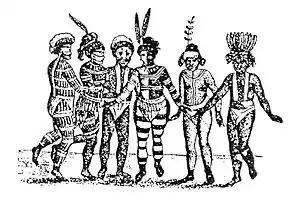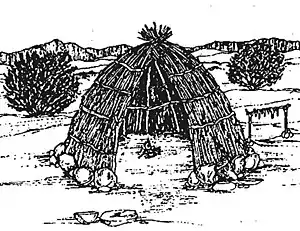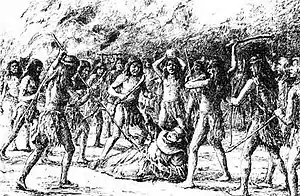| Part of a series on the |
| Spanish missions in California |
|---|
The California mission clash of cultures occurred at the Spanish Missions in California during the Spanish Las Californias-New Spain and Mexican Alta California eras of control, with lasting consequences after American statehood. The Missions were religious outposts established by Spanish Catholic Franciscans from 1769 to 1823 for the purpose of protecting Spain's territory by settlements and converting the Californian Native Americans to the Christian religion.
The Spanish occupation of California brought some negative consequences to the Native American cultures and populations, both those the missionaries were in contact with and others that were traditional trading partners. These aspects have received more research in recent decades.
Spanish era history
One of the tasks assigned to early Spanish explorers of California was to report on the native peoples found there. The Portolá expedition of 1769-70 was the first European land exploration, reaching as far north as San Francisco Bay. Several members of the expedition kept diaries that, among other things, described interactions with and observations about the natives. The most detailed of these diaries was by Franciscan missionary Juan Crespí. A report written later by Pedro Fages, one of the expedition's military officers, was also influential.[1]

Before the padres could abandon their interim missions and begin work on more permanent structures, they had to first attract and convert a sufficiently large number of local Indians, who would comprise the major portion of their work force. The priests offered beads, clothing, blankets, even food to the "gentiles" to attract them to the prospects of mission life and convince them to move into the mission compound or a nearby village. Each Indian was expected to contribute a certain number of hours' labor each week towards making adobes or roof tiles, working on construction crews, performing some type of handicraft, or farming. Women wove cloth, prepared meals, washed clothes, and were generally responsible for whatever domestic chores arose at the mission.
The hierarchy of power in missions was a major cause of culture clash between Franciscan missionaries and Native Americans. Missionaries devolved authority to Native American officials who often held power within their own tribes, but this authority clashed with their own cultural values. Social organization in precontact California is scarcely recorded, but a ruling elite presided over commoners and an underclass, determined by lineage and cultural inheritance. Conversely, mission power structure was determined by elections, eliminating traditional Native American social hierarchy and replacing it with a system heavily monitored and often controlled by Franciscans.[3]
Native American officials were often tasked with keeping the peace between missionaries and Native American inhabitants, leading to increased friction between officials and their unelected counterparts.[3] Regarding the duty of officials, Junípero Serra wrote in a letter to his trusted subordinate Fermín Lasuén: "Ask him to carry out this function so that, without failing in the slightest degree in his duty toward his superior officer, the Indians may not be given a less exalted opinion of the fathers than they have had until now."[4]
In 1811, the Spanish Viceroy in Mexico sent an interrogatorio (questionnaire) to all missions in Alta California regarding the customs, disposition, and condition of the Mission Indians.[5] The replies, which varied greatly in length, spirit, and even value of information, were collected and prefaced by the Father-Presidente with a short general statement or abstract. He sent the compilation to the viceregal government.[6] The contemporary nature of the responses, no matter how incomplete or biased some may be, are nonetheless of considerable value to modern ethnologists. The Indians also spent much of their days learning the Christian faith, and attended worship services several times a day (Fray Gerónimo Boscana, a Franciscan scholar who was stationed at Mission San Juan Capistrano for more than a decade beginning in 1812, compiled what is widely considered to be the most comprehensive study of prehistoric religious practices in the San Juan Capistrano valley).[7]
Mexican era history
When Spain lost control of Las Californias and all of New Spain, due to the Mexican War for Independence succeeding, it left primarily Spanish Franciscan missionaries, suspect by the new Mexican government, managing the mission building complexes in the new Alta California. The Mexican secularization act of 1833 ended the mission system. Much of the prime agricultural lands had Californios with Spanish land grants who remained, who tended to utilize the Indian peoples as a form of enslaved labor. The Mexican land grant period formed many more ranchos in California from mission and Native American lands.
Contemporary research
In recent years, much debate has arisen as to the actual treatment of the Indians during the Mission Period, and Native American scholars claim that the California Mission system is directly responsible for the decline of the Native American populations.[9] For many years, it was commonly taught that the Indians enjoyed their new lives, and that many were able to sustain themselves after the fall of the mission system by utilizing the skills they had acquired at the missions. The Indians were purportedly often granted leave to visit their villages and participated in many ceremonies and celebrations throughout the year at the urging of their benefactors. Modern anthropologists cite a cultural bias on the part of the missionaries that blinded them to the natives' plight and caused them to develop strong negative opinions of the Californian Native Americans.[10]
Evidence has now been brought to light that puts the Californian Native Americans' experiences in a very different context.[11] For instance, women were quartered separately from the men, regardless of marital status. In addition, Native American cultural and spiritual beliefs about marriage, love, and sex were routinely disrespected or punished.[9] Once an Indian agreed to become part of the mission community, he or she was forbidden to leave it without a padre's permission, and from then on led a fairly regimented life learning "civilized" ways from the Spaniards. Indians were often subjected to corporal punishment and other discipline as determined by the padres.[12]
The canonization of Junípero Serra continues to spark contemporary debate regarding the treatment of Native Americans at the hands of Franciscan missionaries. In reaction to Pope Francis's announcement that he would canonize Serra in January 2015 was, a statue of Christ in a cemetery at Mission San Gabriel in Los Angeles was toppled, and a MoveOn petition to "enlighten" the pope regarding “the deception, exploitation, oppression, enslavement, and genocide” of Native Americans received over 10,000 signatures.[13]
Population
The pre-contact population of California (225,000) had been reduced by 33 percent during Spanish and Mexican rule, but that was caused mostly by epidemics. Under American rule (from 1848 on), when most of the twenty-one missions were in ruins, the loss of indigenous lives was catastrophic—80 percent died, leaving just 30,000 in 1870. And nearly half of those losses were due not to disease, but to murder.[13] Baja California experienced a similar reduction in native population resulting from Spanish colonization efforts there.[14][15]
See also
References
- Cook, Sherburne F., Ph.D. (1976). The Population of the California Indians, 1769-1970. University of California Press, Berkeley, CA. ISBN 0-520-02923-2.
{{cite book}}: CS1 maint: multiple names: authors list (link) - Crump, S. (1975). California's Spanish Missions: Their Yesterdays and Todays. Trans-Anglo Books, Del Mar, CA. ISBN 0-87046-028-5.

- Engelhardt, Zephyrin, O.F.M. (1922). San Juan Capistrano Mission. Standard Printing Co., Los Angeles, CA.
{{cite book}}: CS1 maint: multiple names: authors list (link) - Geiger, M., O.F.M. (1969). Franciscan Missionaries in Hispanic California, 1769-1848: A Biographical Dictionary. Huntington Library, San Marino, CA.
{{cite book}}: CS1 maint: multiple names: authors list (link) - Johnson, P., ed. (1964). The California Missions. Lane Book Company, Menlo Park, CA.
{{cite book}}:|author=has generic name (help)CS1 maint: multiple names: authors list (link) - Hittell, Theodore H. (1898). History of California, VOlume I. N.J. Stone & Company, San Francisco, CA.
- Kelsey, H. (1993). Mission San Juan Capistrano: A Pocket History. Interdisciplinary Research, Inc., Altadena, CA.
- Kroeber, Alfred L. (1908). "A Mission Record of the California Indians". University of California Publications in American Archaeology and Ethnology. 8 (1): 1–27.
- Lippy, Charles H. (1985). Bibliography of Religion in the South. Mercer University Press, Macon, GA.
- McKanna, Clare Vernon (2002). Race and Homicide in Nineteenth-Century California. University of Nevada Press, Reno, NV. ISBN 0-87417-515-1.
- Meadows, D. (1965). "The First Europeans Contact with the Indians." Pacific Archaeological Society Quarterly 1 (3) 25–29.
- Paddison, Joshua, ed. (1999). A World Transformed: Firsthand Accounts of California Before the Gold Rush. Heyday Books, Berkeley, CA. ISBN 1-890771-13-9.
- Rawls, James J. (1984). Indians of California: The Changing Image. University of Oklahoma Press, Norman, OK. ISBN 0-8061-2020-7.
- Ruscin, Terry (1999). Mission Memoirs. Sunbelt Publications, San Diego, CA. ISBN 0-932653-30-8.
- Wright, R. (1950). California's Missions. Hubert A. and Martha H. Lowman, Arroyo Grande, CA.
Notes


.[20]
- ↑ A historical, political, and natural description of California, by Pedro Fages and Herbert Ingram Priestley (1937). Berkeley: University of California Press.
- ↑ Paddison, p. 130
- 1 2 Hackel, Steven W. (1997). "The Staff of Leadership: Indian Authority in the Missions of Alta California". The William and Mary Quarterly. 54 (2): 347–376. doi:10.2307/2953277. ISSN 0043-5597. JSTOR 2953277.
- ↑ Serra, Junípero (1984). A letter of Junipero Serra to the reverend father preacher Fray Fermin Francisco de Lasuen : a bicentennial discovery. Press in Hugus Alley. OCLC 12667337.
- ↑ Kroeber, p. 1
- ↑ Kroeber, p. 2: "Some of the missionaries evidently regarded compliance with the instructions of the questionnaire as an official requirement which was perfunctorily performed. In many cases no answers were given various questions at certain of the missions."
- ↑ Rawls, p. 26: Boscana deduced that the "Indians of California may be compared to a species of monkey" and described the native beliefs and customs as "horrible," "ludicrous," and "ridiculous."
- ↑ Kelsey, p. 4
- 1 2 McCormack, Brian T. “Conjugal Violence, Sex, Sin, and Murder in the Mission Communities of Alta California.” Journal of the History of Sexuality 16, no. 3 (December 4, 2007): 391–415. doi:10.1353/sex.2007.0070.
- ↑ McKanna, p. 15; also, per Hittell, p. 753: "Boscana himself and his brother missionaries were men of narrow range of thought, continually seeking among the superstitions of the natives for resemblances of the true faith and ever ready to catch at the slightest hints and magnify them into complicated dogmas corresponding afar of those they themselves taught."
- ↑ Lippy, p. 47: "A matter of debate in reflecting on the role of Spanish missions concerns the degree to which the Spanish colonial regimes regarded the work of the priests as a legitimate religious enterprise and the degree to which it was viewed as a 'frontier institution,' part of a colonial defense program. That is, were Spanish motives based on a desire to promote conversion or on a desire to have religious missions serve as a buffer to protect the main colonial settlements and an aid in controlling the Indians?"
- ↑ Recovering History, Constructing Race: The Indian, Black, and White Roots of Mexican Americans; (Joe R. and Teresa Lozano Long Series in Latin American and Latino Art and Culture); Martha Menchaca; University of Texas Press, 2001; Pgs 138-147
- 1 2 Orfalea, Gregory. "Hungry for Souls: Was Junípero Serra a Saint?". Commonweal. Retrieved 11 December 2015.
- ↑ Rawls, p. 6: Estimates for the pre-contact populations of most native groups in California have been based on a number of different sources, and therefore vary substantially; see Population of Native California.
- ↑ Cook, p. 200: When assessing the relative importance of the various sources of the native population decline in California, including Old World epidemic diseases, violence, nutritional changes, and cultural shock, it is clear that declines tended to be steepest in the areas directly affected by the missions and the Gold Rush. "The first (factor) was the food supply...The second factor was disease...A third factor, which strongly intensified the effect of the other two, was the social and physical disruption visited upon the Indian. He was driven from his home by the thousands, starved, beaten, raped, and murdered with impunity. He was not only given no assistance in the struggle against foreign diseases, but was prevented from adopting even the most elementary measures to secure his food, clothing, and shelter. The utter devastation caused by the white man was literally incredible, and not until the population figures are examined does the extent of the havoc become evident."
- ↑ Rawls, p. 29: In the late 1780s, French naval officer and explorer Jean-François de Galaup, comte de La Pérouse described the native dwellings in and around Monterey—consisting of long poles stuck in the ground and drawn together to form arches, then covered with thatch—as "...the most miserable that are to be met with among any people."
- ↑ Ruscin, p. 12
- ↑ Paddison, p. 48
- ↑ Engelhardt 1922, p. 12: Not all of the native cultures responded with hostility to the Spaniards' presence; Engelhardt portrayed the natives at Mission San Juan Capistrano (dubbed the "Juaneño" by the missionaries), where there was never any instance of unrest, as being "uncommonly friendly and docile." Father Juan Crespí, who accompanied 1769 expedition, described the first encounter with the area's inhabitants: "They came unarmed and with a gentleness which has no name they brought their poor seeds to us as gifts...The locality itself and the docility of the Indians invited the establishment of a Mission for them."
- ↑ Engelhardt, p. 258
External links
- California Historical Society official website
- California Mission Studies Association official website
- California State Board of Education's Grade Four History-Social Science Content Standards (Section 4.2) Archived 2005-04-04 at the Wayback Machine – outlines the curriculum requirements as regards "the Spanish mission and Mexican rancho periods" (among other subjects), a topic of some controversy due to its perceived deliberate inaccuracies
- "Chinigchinich; a Historical Account of the Origin, Customs, and Traditions of the Indians at the Missionary Establishment of St. Juan Capistrano, Alta California Called The Acagchemem Nation" by The Reverend Father Friar Gerónimo Boscana, 1846
- Daily Life at Mission San Juan Capistrano (PDF)
- Early California History: The Missions
- Early California Population Project (ECPP) – provides public access to all the information contained in California's historic mission registers
- The Humanity of Junípero Serra, an article by Thomas Davis at the Serra International official website
- Indians of the Mission (San Juan Capistrano) (PDF)
- The Old Franciscan Missions of California eText at Project Gutenberg
- A Problematic Partnership? (When Church and State Collide: Christian History), an article by Steven Gertz in the December 9, 2004 newsletter of Christianity Today.com
- The San Diego Founders Trail official website
- Sociopolitical Aspects of the 1775 Revolt at Mission San Diego de Alcalá: an Ethnohistorical Approach, an article by Richard L. Carrico in the Summer 1997 issue of The Journal of San Diego History

